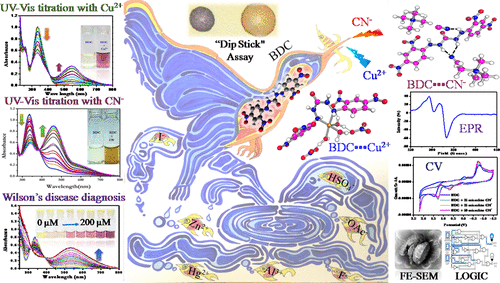当前位置:
X-MOL 学术
›
Ind. Eng. Chem. Res.
›
论文详情
Our official English website, www.x-mol.net, welcomes your feedback! (Note: you will need to create a separate account there.)
A Urea-Functionalized Chemoreceptor for Expeditious Chromogenic Recognition of Toxic Industrial Pollutants Cu2+ and CN– from Real Water Sources and Biofluids: Diagnosis of Wilson’s disease from Human Urine
Industrial & Engineering Chemistry Research ( IF 4.2 ) Pub Date : 2020-09-30 , DOI: 10.1021/acs.iecr.0c02695 Suparna Paul 1, 2 , Riyanka Das 1, 2 , Madhupa Seth 3 , Harish Hirani 4, 5 , Naresh Chandra Murmu 1, 2 , Priyabrata Banerjee 1, 2
Industrial & Engineering Chemistry Research ( IF 4.2 ) Pub Date : 2020-09-30 , DOI: 10.1021/acs.iecr.0c02695 Suparna Paul 1, 2 , Riyanka Das 1, 2 , Madhupa Seth 3 , Harish Hirani 4, 5 , Naresh Chandra Murmu 1, 2 , Priyabrata Banerjee 1, 2
Affiliation

|
A urea-functionalized chemoreceptor 1,5-bis(2,4-dinitrophenyl)carbonohydrazide (BDC) with versatile applications has been reported in this work. BDC displayed ditopic sensitivity toward toxic industrial pollutants Cu2+ and CN– from a purely aqueous medium. BDC has been structurally authenticated by ESI-MS, 1H-NMR, FT-IR, and SCXRD. It can undergo promising “naked eye” detection in the existence of the targeted analytes (pale yellow to dark purple for Cu2+ and pale yellow to dark brown for CN–) in the sub-nanomolar detection threshold (Cu2+: 46 × 10–8 M and CN–: 92 × 10–8 M). The LMCT-ICT and intermolecular H-bonding pathways rationalize the underlying sensing mechanism. A good substantiation of solution-state experimental outcome and theoretical (DFT) evidence further authenticated the recognition pathway. BDC displays reversibility with alternate CN– and Cd2+ addition up to several cycles that serves to be a reliable system toward mimicking molecular logic gate functions. The cytotoxicity assay of BDC on Bacillus thuringiensis (Bt) exhibit its biocompatibility. Furthermore, BDC can efficiently undergo rapid on-site Cu2+ and CN– detection in varying real water sources, and interestingly, BDC can recognize the presence of Cu2+ from biofluids like fetal bovine serum (LOD 13 μM) with a distinct colorimetric response. Moreover, the unprecedented novelty of biocompatible BDC lies in its ability to detect Cu2+ from a human urine specimen as low as 1.5 μM by concentration-dependent discriminative chromogenic responses. This makes BDC an inimitable exploratory symptomatic tool for Wilson’s disease, which to the best of our knowledge to date has been rarely explored in the supramolecular realm. One step ahead, solid-state on-spot chromogenic detection of aqueous Cu2+ and CN– by the “dip stick” method escalates the practical application of this work.
中文翻译:

尿素功能化化学感受器有毒工业污染物铜的显色特快承认2+和CN -从人尿诊断威尔逊氏病:从皇家水源和生物流体
这项工作已报告了具有通用用途的脲官能化化学感受器1,5-双(2,4-二硝基苯基)碳酰肼(BDC)。BDC对纯水介质中的有毒工业污染物Cu 2+和CN –表现出对位的敏感性。BDC已通过ESI-MS,1 H-NMR,FT-IR和SCXRD在结构上进行了认证。在亚纳摩尔级检测阈值(Cu 2+:46× )下,可以针对目标分析物(对于Cu 2+为浅黄色至深紫色,对于CN –为浅黄色至深棕色)进行有希望的“裸眼”检测。10 –8 M和CN –:92×10 –8 M)。LMCT-ICT和分子间氢键途径合理化了潜在的传感机制。溶液状态实验结果和理论(DFT)证据的充分证实进一步证实了识别途径。BDC显示可逆性具有交替CN -和Cd 2+除了高达几个周期,其用于朝向模仿分子逻辑门功能的可靠的系统。BDC对苏云金芽孢杆菌(Bt)的细胞毒性试验显示出其生物相容性。此外,BDC可以有效地进行快速的现场Cu 2+和CN –在各种实际水源中进行检测,有趣的是,BDC可以从生物流体(如胎牛血清(LOD 13μM))中识别出Cu 2+,并具有明显的色度响应。此外,生物相容性BDC前所未有的新颖之处在于它能够通过浓度依赖性判别发色反应从低至1.5μM的人类尿液样本中检测Cu 2+。这使BDC成为针对威尔逊氏病的独特探索性症状工具,据我们所知,迄今为止,在超分子领域中很少探索到这一点。向前迈进了一步,对Cu 2+和CN –水溶液进行了固态现场发色检测 通过“浸油杆”法升级了这项工作的实际应用。
更新日期:2020-10-29
中文翻译:

尿素功能化化学感受器有毒工业污染物铜的显色特快承认2+和CN -从人尿诊断威尔逊氏病:从皇家水源和生物流体
这项工作已报告了具有通用用途的脲官能化化学感受器1,5-双(2,4-二硝基苯基)碳酰肼(BDC)。BDC对纯水介质中的有毒工业污染物Cu 2+和CN –表现出对位的敏感性。BDC已通过ESI-MS,1 H-NMR,FT-IR和SCXRD在结构上进行了认证。在亚纳摩尔级检测阈值(Cu 2+:46× )下,可以针对目标分析物(对于Cu 2+为浅黄色至深紫色,对于CN –为浅黄色至深棕色)进行有希望的“裸眼”检测。10 –8 M和CN –:92×10 –8 M)。LMCT-ICT和分子间氢键途径合理化了潜在的传感机制。溶液状态实验结果和理论(DFT)证据的充分证实进一步证实了识别途径。BDC显示可逆性具有交替CN -和Cd 2+除了高达几个周期,其用于朝向模仿分子逻辑门功能的可靠的系统。BDC对苏云金芽孢杆菌(Bt)的细胞毒性试验显示出其生物相容性。此外,BDC可以有效地进行快速的现场Cu 2+和CN –在各种实际水源中进行检测,有趣的是,BDC可以从生物流体(如胎牛血清(LOD 13μM))中识别出Cu 2+,并具有明显的色度响应。此外,生物相容性BDC前所未有的新颖之处在于它能够通过浓度依赖性判别发色反应从低至1.5μM的人类尿液样本中检测Cu 2+。这使BDC成为针对威尔逊氏病的独特探索性症状工具,据我们所知,迄今为止,在超分子领域中很少探索到这一点。向前迈进了一步,对Cu 2+和CN –水溶液进行了固态现场发色检测 通过“浸油杆”法升级了这项工作的实际应用。


























 京公网安备 11010802027423号
京公网安备 11010802027423号